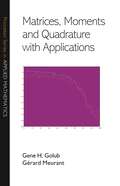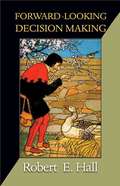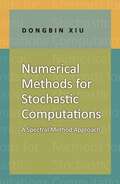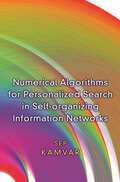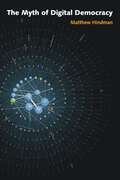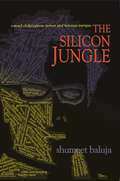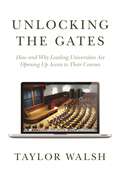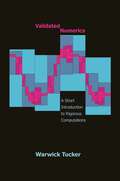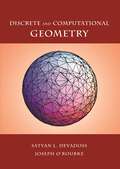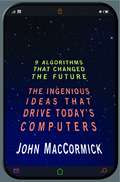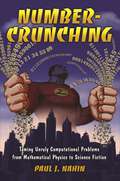- Table View
- List View
Matrices, Moments and Quadrature with Applications
by Gene H. Golub Gérard MeurantThis computationally oriented book describes and explains the mathematical relationships among matrices, moments, orthogonal polynomials, quadrature rules, and the Lanczos and conjugate gradient algorithms. The book bridges different mathematical areas to obtain algorithms to estimate bilinear forms involving two vectors and a function of the matrix. The first part of the book provides the necessary mathematical background and explains the theory. The second part describes the applications and gives numerical examples of the algorithms and techniques developed in the first part. Applications addressed in the book include computing elements of functions of matrices; obtaining estimates of the error norm in iterative methods for solving linear systems and computing parameters in least squares and total least squares; and solving ill-posed problems using Tikhonov regularization. This book will interest researchers in numerical linear algebra and matrix computations, as well as scientists and engineers working on problems involving computation of bilinear forms.
Matrices, Moments and Quadrature with Applications (Princeton Series in Applied Mathematics #30)
by Gene H. Golub Gérard MeurantThis computationally oriented book describes and explains the mathematical relationships among matrices, moments, orthogonal polynomials, quadrature rules, and the Lanczos and conjugate gradient algorithms. The book bridges different mathematical areas to obtain algorithms to estimate bilinear forms involving two vectors and a function of the matrix. The first part of the book provides the necessary mathematical background and explains the theory. The second part describes the applications and gives numerical examples of the algorithms and techniques developed in the first part. Applications addressed in the book include computing elements of functions of matrices; obtaining estimates of the error norm in iterative methods for solving linear systems and computing parameters in least squares and total least squares; and solving ill-posed problems using Tikhonov regularization. This book will interest researchers in numerical linear algebra and matrix computations, as well as scientists and engineers working on problems involving computation of bilinear forms.
Forward-Looking Decision Making: Dynamic Programming Models Applied to Health, Risk, Employment, and Financial Stability
by Robert E. HallIndividuals and families make key decisions that impact many aspects of financial stability and determine the future of the economy. These decisions involve balancing current sacrifice against future benefits. People have to decide how much to invest in health care, exercise, their diet, and insurance. They must decide how much debt to take on, and how much to save. And they make choices about jobs that determine employment and unemployment levels. Forward-Looking Decision Making is about modeling this individual or family-based decision making using an optimizing dynamic programming model. Robert Hall first reviews ideas about dynamic programs and introduces new ideas about numerical solutions and the representation of solved models as Markov processes. He surveys recent research on the parameters of preferences--the intertemporal elasticity of substitution, the Frisch elasticity of labor supply, and the Frisch cross-elasticity. He then examines dynamic programming models applied to health spending, long-term care insurance, employment, entrepreneurial risk-taking, and consumer debt. Linking theory with data and applying them to real-world problems, Forward-Looking Decision Making uses dynamic optimization programming models to shed light on individual behaviors and their economic implications.
Numerical Methods for Stochastic Computations: A Spectral Method Approach
by Dongbin XiuThe@ first graduate-level textbook to focus on fundamental aspects of numerical methods for stochastic computations, this book describes the class of numerical methods based on generalized polynomial chaos (gPC). These fast, efficient, and accurate methods are an extension of the classical spectral methods of high-dimensional random spaces. Designed to simulate complex systems subject to random inputs, these methods are widely used in many areas of computer science and engineering. The book introduces polynomial approximation theory and probability theory; describes the basic theory of gPC methods through numerical examples and rigorous development; details the procedure for converting stochastic equations into deterministic ones; using both the Galerkin and collocation approaches; and discusses the distinct differences and challenges arising from high-dimensional problems. The last section is devoted to the application of gPC methods to critical areas such as inverse problems and data assimilation. Ideal for use by graduate students and researchers both in the classroom and for self-study, Numerical Methods for Stochastic Computations provides the required tools for in-depth research related to stochastic computations. The first graduate-level textbook to focus on the fundamentals of numerical methods for stochastic computations Ideal introduction for graduate courses or self-study Fast, efficient, and accurate numerical methods Polynomial approximation theory and probability theory included Basic gPC methods illustrated through examples
Numerical Methods for Stochastic Computations: A Spectral Method Approach
by Dongbin XiuThe@ first graduate-level textbook to focus on fundamental aspects of numerical methods for stochastic computations, this book describes the class of numerical methods based on generalized polynomial chaos (gPC). These fast, efficient, and accurate methods are an extension of the classical spectral methods of high-dimensional random spaces. Designed to simulate complex systems subject to random inputs, these methods are widely used in many areas of computer science and engineering. The book introduces polynomial approximation theory and probability theory; describes the basic theory of gPC methods through numerical examples and rigorous development; details the procedure for converting stochastic equations into deterministic ones; using both the Galerkin and collocation approaches; and discusses the distinct differences and challenges arising from high-dimensional problems. The last section is devoted to the application of gPC methods to critical areas such as inverse problems and data assimilation. Ideal for use by graduate students and researchers both in the classroom and for self-study, Numerical Methods for Stochastic Computations provides the required tools for in-depth research related to stochastic computations. The first graduate-level textbook to focus on the fundamentals of numerical methods for stochastic computations Ideal introduction for graduate courses or self-study Fast, efficient, and accurate numerical methods Polynomial approximation theory and probability theory included Basic gPC methods illustrated through examples
Dynamic Programming (Princeton Landmarks in Mathematics and Physics #33)
by Richard E. BellmanThis classic book is an introduction to dynamic programming, presented by the scientist who coined the term and developed the theory in its early stages. In Dynamic Programming, Richard E. Bellman introduces his groundbreaking theory and furnishes a new and versatile mathematical tool for the treatment of many complex problems, both within and outside of the discipline. The book is written at a moderate mathematical level, requiring only a basic foundation in mathematics, including calculus. The applications formulated and analyzed in such diverse fields as mathematical economics, logistics, scheduling theory, communication theory, and control processes are as relevant today as they were when Bellman first presented them. A new introduction by Stuart Dreyfus reviews Bellman's later work on dynamic programming and identifies important research areas that have profited from the application of Bellman's theory.
Numerical Algorithms for Personalized Search in Self-organizing Information Networks
by Sep KamvarThis book lays out the theoretical groundwork for personalized search and reputation management, both on the Web and in peer-to-peer and social networks. Representing much of the foundational research in this field, the book develops scalable algorithms that exploit the graphlike properties underlying personalized search and reputation management, and delves into realistic scenarios regarding Web-scale data. Sep Kamvar focuses on eigenvector-based techniques in Web search, introducing a personalized variant of Google's PageRank algorithm, and he outlines algorithms--such as the now-famous quadratic extrapolation technique--that speed up computation, making personalized PageRank feasible. Kamvar suggests that Power Method-related techniques ultimately should be the basis for improving the PageRank algorithm, and he presents algorithms that exploit the convergence behavior of individual components of the PageRank vector. Kamvar then extends the ideas of reputation management and personalized search to distributed networks like peer-to-peer and social networks. He highlights locality and computational considerations related to the structure of the network, and considers such unique issues as malicious peers. He describes the EigenTrust algorithm and applies various PageRank concepts to P2P settings. Discussion chapters summarizing results conclude the book's two main sections. Clear and thorough, this book provides an authoritative look at central innovations in search for all of those interested in the subject.
Numerical Algorithms for Personalized Search in Self-organizing Information Networks
by Sep KamvarThis book lays out the theoretical groundwork for personalized search and reputation management, both on the Web and in peer-to-peer and social networks. Representing much of the foundational research in this field, the book develops scalable algorithms that exploit the graphlike properties underlying personalized search and reputation management, and delves into realistic scenarios regarding Web-scale data. Sep Kamvar focuses on eigenvector-based techniques in Web search, introducing a personalized variant of Google's PageRank algorithm, and he outlines algorithms--such as the now-famous quadratic extrapolation technique--that speed up computation, making personalized PageRank feasible. Kamvar suggests that Power Method-related techniques ultimately should be the basis for improving the PageRank algorithm, and he presents algorithms that exploit the convergence behavior of individual components of the PageRank vector. Kamvar then extends the ideas of reputation management and personalized search to distributed networks like peer-to-peer and social networks. He highlights locality and computational considerations related to the structure of the network, and considers such unique issues as malicious peers. He describes the EigenTrust algorithm and applies various PageRank concepts to P2P settings. Discussion chapters summarizing results conclude the book's two main sections. Clear and thorough, this book provides an authoritative look at central innovations in search for all of those interested in the subject.
The Myth of Digital Democracy
by Matthew HindmanIs the Internet democratizing American politics? Do political Web sites and blogs mobilize inactive citizens and make the public sphere more inclusive? The Myth of Digital Democracy reveals that, contrary to popular belief, the Internet has done little to broaden political discourse but in fact empowers a small set of elites--some new, but most familiar. Matthew Hindman argues that, though hundreds of thousands of Americans blog about politics, blogs receive only a miniscule portion of Web traffic, and most blog readership goes to a handful of mainstream, highly educated professionals. He shows how, despite the wealth of independent Web sites, online news audiences are concentrated on the top twenty outlets, and online organizing and fund-raising are dominated by a few powerful interest groups. Hindman tracks nearly three million Web pages, analyzing how their links are structured, how citizens search for political content, and how leading search engines like Google and Yahoo! funnel traffic to popular outlets. He finds that while the Internet has increased some forms of political participation and transformed the way interest groups and candidates organize, mobilize, and raise funds, elites still strongly shape how political material on the Web is presented and accessed. The Myth of Digital Democracy. debunks popular notions about political discourse in the digital age, revealing how the Internet has neither diminished the audience share of corporate media nor given greater voice to ordinary citizens.
The Myth of Digital Democracy
by Matthew HindmanIs the Internet democratizing American politics? Do political Web sites and blogs mobilize inactive citizens and make the public sphere more inclusive? The Myth of Digital Democracy reveals that, contrary to popular belief, the Internet has done little to broaden political discourse but in fact empowers a small set of elites--some new, but most familiar. Matthew Hindman argues that, though hundreds of thousands of Americans blog about politics, blogs receive only a miniscule portion of Web traffic, and most blog readership goes to a handful of mainstream, highly educated professionals. He shows how, despite the wealth of independent Web sites, online news audiences are concentrated on the top twenty outlets, and online organizing and fund-raising are dominated by a few powerful interest groups. Hindman tracks nearly three million Web pages, analyzing how their links are structured, how citizens search for political content, and how leading search engines like Google and Yahoo! funnel traffic to popular outlets. He finds that while the Internet has increased some forms of political participation and transformed the way interest groups and candidates organize, mobilize, and raise funds, elites still strongly shape how political material on the Web is presented and accessed. The Myth of Digital Democracy. debunks popular notions about political discourse in the digital age, revealing how the Internet has neither diminished the audience share of corporate media nor given greater voice to ordinary citizens.
The Silicon Jungle: A Novel of Deception, Power, and Internet Intrigue
by Shumeet BalujaWhat happens when a naive intern is granted unfettered access to people's most private thoughts and actions? Stephen Thorpe lands a coveted internship at Ubatoo, an Internet empire that provides its users with popular online services, from a search engine and e-mail, to social networking. When Stephen’s boss asks him to work on a project with the American Coalition for Civil Liberties, Stephen innocently obliges, believing he is mining Ubatoo’s vast databases to protect people unfairly targeted in the name of national security. But nothing is as it seems. Suspicious individuals surface, doing all they can to access Ubatoo’s wealth of confidential information. This need not require technical wizardry—simply knowing how to manipulate a well-intentioned intern may be enough. The Silicon Jungle is a cautionary fictional tale of data mining’s promise and peril. Baluja raises ethical questions about contemporary technological innovations, and how minute details can be routinely pieced together into rich profiles that reveal our habits, goals, and secret desires—all ready to be exploited.
The Silicon Jungle: A Novel of Deception, Power, and Internet Intrigue
by Shumeet BalujaWhat happens when a naive intern is granted unfettered access to people's most private thoughts and actions? Stephen Thorpe lands a coveted internship at Ubatoo, an Internet empire that provides its users with popular online services, from a search engine and e-mail, to social networking. When Stephen’s boss asks him to work on a project with the American Coalition for Civil Liberties, Stephen innocently obliges, believing he is mining Ubatoo’s vast databases to protect people unfairly targeted in the name of national security. But nothing is as it seems. Suspicious individuals surface, doing all they can to access Ubatoo’s wealth of confidential information. This need not require technical wizardry—simply knowing how to manipulate a well-intentioned intern may be enough. The Silicon Jungle is a cautionary fictional tale of data mining’s promise and peril. Baluja raises ethical questions about contemporary technological innovations, and how minute details can be routinely pieced together into rich profiles that reveal our habits, goals, and secret desires—all ready to be exploited.
Delete: The Virtue of Forgetting in the Digital Age
by Viktor Mayer-SchönbergerDelete looks at the surprising phenomenon of perfect remembering in the digital age, and reveals why we must reintroduce our capacity to forget. Digital technology empowers us as never before, yet it has unforeseen consequences as well. Potentially humiliating content on Facebook is enshrined in cyberspace for future employers to see. Google remembers everything we've searched for and when. The digital realm remembers what is sometimes better forgotten, and this has profound implications for us all. In Delete, Viktor Mayer-Schönberger traces the important role that forgetting has played throughout human history, from the ability to make sound decisions unencumbered by the past to the possibility of second chances. The written word made it possible for humans to remember across generations and time, yet now digital technology and global networks are overriding our natural ability to forget--the past is ever present, ready to be called up at the click of a mouse. Mayer-Schönberger examines the technology that's facilitating the end of forgetting--digitization, cheap storage and easy retrieval, global access, and increasingly powerful software--and describes the dangers of everlasting digital memory, whether it's outdated information taken out of context or compromising photos the Web won't let us forget. He explains why information privacy rights and other fixes can't help us, and proposes an ingeniously simple solution--expiration dates on information--that may. Delete is an eye-opening book that will help us remember how to forget in the digital age.
Delete: The Virtue of Forgetting in the Digital Age (PDF)
by Viktor Mayer-SchönbergerDelete looks at the surprising phenomenon of perfect remembering in the digital age, and reveals why we must reintroduce our capacity to forget. Digital technology empowers us as never before, yet it has unforeseen consequences as well. Potentially humiliating content on Facebook is enshrined in cyberspace for future employers to see. Google remembers everything we've searched for and when. The digital realm remembers what is sometimes better forgotten, and this has profound implications for us all. In Delete, Viktor Mayer-Schönberger traces the important role that forgetting has played throughout human history, from the ability to make sound decisions unencumbered by the past to the possibility of second chances. The written word made it possible for humans to remember across generations and time, yet now digital technology and global networks are overriding our natural ability to forget--the past is ever present, ready to be called up at the click of a mouse. Mayer-Schönberger examines the technology that's facilitating the end of forgetting--digitization, cheap storage and easy retrieval, global access, and increasingly powerful software--and describes the dangers of everlasting digital memory, whether it's outdated information taken out of context or compromising photos the Web won't let us forget. He explains why information privacy rights and other fixes can't help us, and proposes an ingeniously simple solution--expiration dates on information--that may. Delete is an eye-opening book that will help us remember how to forget in the digital age.
Unlocking the Gates: How and Why Leading Universities Are Opening Up Access to Their Courses
by Taylor Walsh William G. BowenOver the past decade, a small revolution has taken place at some of the world's leading universities, as they have started to provide free access to undergraduate course materials--including syllabi, assignments, and lectures--to anyone with an Internet connection. Yale offers high-quality audio and video recordings of a careful selection of popular lectures, MIT supplies digital materials for nearly all of its courses, Carnegie Mellon boasts a purpose-built interactive learning environment, and some of the most selective universities in India have created a vast body of online content in order to reach more of the country's exploding student population. Although they don't offer online credit or degrees, efforts like these are beginning to open up elite institutions--and may foreshadow significant changes in the way all universities approach teaching and learning. Unlocking the Gates is one of the first books to examine this important development. Drawing on a wide range of sources, including extensive interviews with university leaders, Taylor Walsh traces the evolution of these online courseware projects and considers the impact they may have, both inside elite universities and beyond. As economic constraints and concerns over access demand more efficient and creative teaching models, these early initiatives may lead to more substantial innovations in how education is delivered and consumed--even at the best institutions. Unlocking the Gates tells an important story about this form of online learning--and what it might mean for the future of higher education.
Unlocking the Gates: How and Why Leading Universities Are Opening Up Access to Their Courses
by Taylor Walsh William G. BowenOver the past decade, a small revolution has taken place at some of the world's leading universities, as they have started to provide free access to undergraduate course materials--including syllabi, assignments, and lectures--to anyone with an Internet connection. Yale offers high-quality audio and video recordings of a careful selection of popular lectures, MIT supplies digital materials for nearly all of its courses, Carnegie Mellon boasts a purpose-built interactive learning environment, and some of the most selective universities in India have created a vast body of online content in order to reach more of the country's exploding student population. Although they don't offer online credit or degrees, efforts like these are beginning to open up elite institutions--and may foreshadow significant changes in the way all universities approach teaching and learning. Unlocking the Gates is one of the first books to examine this important development. Drawing on a wide range of sources, including extensive interviews with university leaders, Taylor Walsh traces the evolution of these online courseware projects and considers the impact they may have, both inside elite universities and beyond. As economic constraints and concerns over access demand more efficient and creative teaching models, these early initiatives may lead to more substantial innovations in how education is delivered and consumed--even at the best institutions. Unlocking the Gates tells an important story about this form of online learning--and what it might mean for the future of higher education.
Validated Numerics: A Short Introduction to Rigorous Computations
by Warwick TuckerThis textbook provides a comprehensive introduction to the theory and practice of validated numerics, an emerging new field that combines the strengths of scientific computing and pure mathematics. In numerous fields ranging from pharmaceutics and engineering to weather prediction and robotics, fast and precise computations are essential. Based on the theory of set-valued analysis, a new suite of numerical methods is developed, producing efficient and reliable solvers for numerous problems in nonlinear analysis. Validated numerics yields rigorous computations that can find all possible solutions to a problem while taking into account all possible sources of error--fast, and with guaranteed accuracy. Validated Numerics offers a self-contained primer on the subject, guiding readers from the basics to more advanced concepts and techniques. This book is an essential resource for those entering this fast-developing field, and it is also the ideal textbook for graduate students and advanced undergraduates needing an accessible introduction to the subject. Validated Numerics features many examples, exercises, and computer labs using MATLAB/C++, as well as detailed appendixes and an extensive bibliography for further reading. Provides a comprehensive, self-contained introduction to validated numerics Requires no advanced mathematics or programming skills Features many examples, exercises, and computer labs Includes code snippets that illustrate implementation Suitable as a textbook for graduate students and advanced undergraduates
Validated Numerics: A Short Introduction to Rigorous Computations
by Warwick TuckerThis textbook provides a comprehensive introduction to the theory and practice of validated numerics, an emerging new field that combines the strengths of scientific computing and pure mathematics. In numerous fields ranging from pharmaceutics and engineering to weather prediction and robotics, fast and precise computations are essential. Based on the theory of set-valued analysis, a new suite of numerical methods is developed, producing efficient and reliable solvers for numerous problems in nonlinear analysis. Validated numerics yields rigorous computations that can find all possible solutions to a problem while taking into account all possible sources of error--fast, and with guaranteed accuracy. Validated Numerics offers a self-contained primer on the subject, guiding readers from the basics to more advanced concepts and techniques. This book is an essential resource for those entering this fast-developing field, and it is also the ideal textbook for graduate students and advanced undergraduates needing an accessible introduction to the subject. Validated Numerics features many examples, exercises, and computer labs using MATLAB/C++, as well as detailed appendixes and an extensive bibliography for further reading. Provides a comprehensive, self-contained introduction to validated numerics Requires no advanced mathematics or programming skills Features many examples, exercises, and computer labs Includes code snippets that illustrate implementation Suitable as a textbook for graduate students and advanced undergraduates
Discrete and Computational Geometry
by Satyan L. Devadoss Joseph O'RourkeDiscrete geometry is a relatively new development in pure mathematics, while computational geometry is an emerging area in applications-driven computer science. Their intermingling has yielded exciting advances in recent years, yet what has been lacking until now is an undergraduate textbook that bridges the gap between the two. Discrete and Computational Geometry offers a comprehensive yet accessible introduction to this cutting-edge frontier of mathematics and computer science. This book covers traditional topics such as convex hulls, triangulations, and Voronoi diagrams, as well as more recent subjects like pseudotriangulations, curve reconstruction, and locked chains. It also touches on more advanced material, including Dehn invariants, associahedra, quasigeodesics, Morse theory, and the recent resolution of the Poincaré conjecture. Connections to real-world applications are made throughout, and algorithms are presented independently of any programming language. This richly illustrated textbook also features numerous exercises and unsolved problems. The essential introduction to discrete and computational geometry Covers traditional topics as well as new and advanced material Features numerous full-color illustrations, exercises, and unsolved problems Suitable for sophomores in mathematics, computer science, engineering, or physics Rigorous but accessible An online solutions manual is available (for teachers only). To obtain access, please e-mail: Vickie_Kearn@press.princeton.edu
Discrete and Computational Geometry (PDF)
by Satyan L. Devadoss Joseph O'RourkeDiscrete geometry is a relatively new development in pure mathematics, while computational geometry is an emerging area in applications-driven computer science. Their intermingling has yielded exciting advances in recent years, yet what has been lacking until now is an undergraduate textbook that bridges the gap between the two. Discrete and Computational Geometry offers a comprehensive yet accessible introduction to this cutting-edge frontier of mathematics and computer science. This book covers traditional topics such as convex hulls, triangulations, and Voronoi diagrams, as well as more recent subjects like pseudotriangulations, curve reconstruction, and locked chains. It also touches on more advanced material, including Dehn invariants, associahedra, quasigeodesics, Morse theory, and the recent resolution of the Poincaré conjecture. Connections to real-world applications are made throughout, and algorithms are presented independently of any programming language. This richly illustrated textbook also features numerous exercises and unsolved problems. The essential introduction to discrete and computational geometry Covers traditional topics as well as new and advanced material Features numerous full-color illustrations, exercises, and unsolved problems Suitable for sophomores in mathematics, computer science, engineering, or physics Rigorous but accessible An online solutions manual is available (for teachers only). To obtain access, please e-mail: Vickie_Kearn@press.princeton.edu
Nine Algorithms That Changed the Future: The Ingenious Ideas That Drive Today's Computers
by John Maccormick Chris BishopEvery day, we use our computers to perform remarkable feats. A simple web search picks out a handful of relevant needles from the world's biggest haystack: the billions of pages on the World Wide Web. Uploading a photo to Facebook transmits millions of pieces of information over numerous error-prone network links, yet somehow a perfect copy of the photo arrives intact. Without even knowing it, we use public-key cryptography to transmit secret information like credit card numbers; and we use digital signatures to verify the identity of the websites we visit. How do our computers perform these tasks with such ease? This is the first book to answer that question in language anyone can understand, revealing the extraordinary ideas that power our PCs, laptops, and smartphones. Using vivid examples, John MacCormick explains the fundamental "tricks" behind nine types of computer algorithms, including artificial intelligence (where we learn about the "nearest neighbor trick" and "twenty questions trick"), Google's famous PageRank algorithm (which uses the "random surfer trick"), data compression, error correction, and much more. These revolutionary algorithms have changed our world: this book unlocks their secrets, and lays bare the incredible ideas that our computers use every day.
Nine Algorithms That Changed the Future: The Ingenious Ideas That Drive Today's Computers
by John Maccormick Chris BishopEvery day, we use our computers to perform remarkable feats. A simple web search picks out a handful of relevant needles from the world's biggest haystack: the billions of pages on the World Wide Web. Uploading a photo to Facebook transmits millions of pieces of information over numerous error-prone network links, yet somehow a perfect copy of the photo arrives intact. Without even knowing it, we use public-key cryptography to transmit secret information like credit card numbers; and we use digital signatures to verify the identity of the websites we visit. How do our computers perform these tasks with such ease? This is the first book to answer that question in language anyone can understand, revealing the extraordinary ideas that power our PCs, laptops, and smartphones. Using vivid examples, John MacCormick explains the fundamental "tricks" behind nine types of computer algorithms, including artificial intelligence (where we learn about the "nearest neighbor trick" and "twenty questions trick"), Google's famous PageRank algorithm (which uses the "random surfer trick"), data compression, error correction, and much more. These revolutionary algorithms have changed our world: this book unlocks their secrets, and lays bare the incredible ideas that our computers use every day.
Nine Algorithms That Changed the Future: The Ingenious Ideas That Drive Today's Computers
by Chris Bishop John MaccormickEvery day, we use our computers to perform remarkable feats. A simple web search picks out a handful of relevant needles from the world's biggest haystack: the billions of pages on the World Wide Web. Uploading a photo to Facebook transmits millions of pieces of information over numerous error-prone network links, yet somehow a perfect copy of the photo arrives intact. Without even knowing it, we use public-key cryptography to transmit secret information like credit card numbers; and we use digital signatures to verify the identity of the websites we visit. How do our computers perform these tasks with such ease? This is the first book to answer that question in language anyone can understand, revealing the extraordinary ideas that power our PCs, laptops, and smartphones. Using vivid examples, John MacCormick explains the fundamental "tricks" behind nine types of computer algorithms, including artificial intelligence (where we learn about the "nearest neighbor trick" and "twenty questions trick"), Google's famous PageRank algorithm (which uses the "random surfer trick"), data compression, error correction, and much more. These revolutionary algorithms have changed our world: this book unlocks their secrets, and lays bare the incredible ideas that our computers use every day.
Number-Crunching: Taming Unruly Computational Problems from Mathematical Physics to Science Fiction
by Paul J. NahinHow do technicians repair broken communications cables at the bottom of the ocean without actually seeing them? What's the likelihood of plucking a needle out of a haystack the size of the Earth? And is it possible to use computers to create a universal library of everything ever written or every photo ever taken? These are just some of the intriguing questions that best-selling popular math writer Paul Nahin tackles in Number-Crunching. Through brilliant math ideas and entertaining stories, Nahin demonstrates how odd and unusual math problems can be solved by bringing together basic physics ideas and today's powerful computers. Some of the outcomes discussed are so counterintuitive they will leave readers astonished. Nahin looks at how the art of number-crunching has changed since the advent of computers, and how high-speed technology helps to solve fascinating conundrums such as the three-body, Monte Carlo, leapfrog, and gambler's ruin problems. Along the way, Nahin traverses topics that include algebra, trigonometry, geometry, calculus, number theory, differential equations, Fourier series, electronics, and computers in science fiction. He gives historical background for the problems presented, offers many examples and numerous challenges, supplies MATLAB codes for all the theories discussed, and includes detailed and complete solutions. Exploring the intimate relationship between mathematics, physics, and the tremendous power of modern computers, Number-Crunching will appeal to anyone interested in understanding how these three important fields join forces to solve today's thorniest puzzles.
Number-Crunching: Taming Unruly Computational Problems from Mathematical Physics to Science Fiction
by Paul J. NahinHow do technicians repair broken communications cables at the bottom of the ocean without actually seeing them? What's the likelihood of plucking a needle out of a haystack the size of the Earth? And is it possible to use computers to create a universal library of everything ever written or every photo ever taken? These are just some of the intriguing questions that best-selling popular math writer Paul Nahin tackles in Number-Crunching. Through brilliant math ideas and entertaining stories, Nahin demonstrates how odd and unusual math problems can be solved by bringing together basic physics ideas and today's powerful computers. Some of the outcomes discussed are so counterintuitive they will leave readers astonished. Nahin looks at how the art of number-crunching has changed since the advent of computers, and how high-speed technology helps to solve fascinating conundrums such as the three-body, Monte Carlo, leapfrog, and gambler's ruin problems. Along the way, Nahin traverses topics that include algebra, trigonometry, geometry, calculus, number theory, differential equations, Fourier series, electronics, and computers in science fiction. He gives historical background for the problems presented, offers many examples and numerous challenges, supplies MATLAB codes for all the theories discussed, and includes detailed and complete solutions. Exploring the intimate relationship between mathematics, physics, and the tremendous power of modern computers, Number-Crunching will appeal to anyone interested in understanding how these three important fields join forces to solve today's thorniest puzzles.
